- Clone
- L263G8 (See other available formats)
- Regulatory Status
- RUO
- Other Names
- CC-CKR-8,C-C CKR-8, CCR-8, CC chemokine receptor 8, CDw198, CDw198 antigen, CD198, chemokine (C-C motif) receptor 8, chemokine (C-C) receptor 8, TER1, ChemR1, and CKR-L1
- Isotype
- Mouse IgG2a, κ
- Ave. Rating
- Submit a Review
- Product Citations
- publications
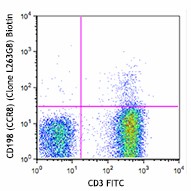
-

Human peripheral blood lymphocytes were stained with CD3 FITC and biotinylated CD198 (CCR8) (clone L263G8) (top) or mouse IgG2a, κ biotin isotype control (bottom), followed by streptavidin PE. -

| Cat # | Size | Price | Quantity Check Availability | Save | ||
|---|---|---|---|---|---|---|
| 360606 | 100 µg | 235 CHF | ||||
CCR8, also known as ChemR1, TER1, and CKR-L1, belongs to the beta chemokine receptor family. It is predicted to be a seven transmembrane protein similar to G protein-coupled receptors. CCR8 is expressed on some subsets of T cells, monocytes, macrophages, eosinophils, thymocytes, Langerhans cells, neurons, and vascular smooth muscle cells. Binding with its ligand CCL1, CCR8 plays a role in the regulation of monocyte chemotaxis and thymic cell apoptosis. It has been reported that CCR8 is also a receptor for CCL18. CCR8 is also believed to be an alternative coreceptor to CD4 for HIV-1 infection.
Product DetailsProduct Details
- Verified Reactivity
- Human
- Antibody Type
- Monoclonal
- Host Species
- Mouse
- Immunogen
- Human CCR8-transfectants
- Formulation
- Phosphate-buffered solution, pH 7.2, containing 0.09% sodium azide.
- Preparation
- The antibody was purified by affinity chromatography and conjugated with biotin under optimal conditions.
- Concentration
- 0.5 mg/ml
- Storage & Handling
- The antibody solution should be stored undiluted between 2°C and 8°C. Do not freeze.
- Application
-
FC - Quality tested
- Recommended Usage
-
Each lot of this antibody is quality control tested by immunofluorescent staining with flow cytometric analysis. For flow cytometric staining, the suggested use of this reagent is ≤0.5 µg per million cells in 100 µl volume. It is recommended that the reagent be titrated for optimal performance for each application.
- RRID
-
AB_2629656 (BioLegend Cat. No. 360606)
Antigen Details
- Structure
- Seven hydrophobic transmembrane domains
- Distribution
-
Vascular smooth muscle cells, macrophages, eosinophils, peritoneal macrophages, thymocytes, T cells, Langerhans cells and neurons
- Function
- Regulation of monocyte chemotaxis and thymic cell apoptosis
- Ligand/Receptor
- CCL1, CCL18
- Cell Type
- Dendritic cells, Eosinophils, Langerhans cells, Macrophages, Neurons, T cells, Thymocytes
- Biology Area
- Cell Biology, Cell Motility/Cytoskeleton/Structure, Immunology, Innate Immunity, Neuroscience, Neuroscience Cell Markers
- Molecular Family
- CD Molecules, Cytokine/Chemokine Receptors, GPCR
- Antigen References
-
1. Tiffany HL, et al. 1997. J. Exp. Med. 186:165.
2. Goya I, et al. 1998. J. Immunol. 160:1975.
3. Lee S, et al. 2000. J. Virol. 74:6946.
4. Chensue SW, et al. 2001. J. Exp. Med. 193:573.
5. Qu C, et al. 2004. J. Exp. Med. 200:1231.
6. Isolam SA, et al. 2003. J. Exp. Med. 210:1889. - Gene ID
- 1237 View all products for this Gene ID
- UniProt
- View information about CD198 on UniProt.org
Related Pages & Pathways
Pages
Related FAQs
- How many biotin molecules are per antibody structure?
- We don't routinely measure the number of biotins with our antibody products but the number of biotin molecules range from 3-6 molecules per antibody.
- Does staining at room temperature or even at 37°C help for checking chemokine receptors expression?
-
Due to continuous recycling of many chemokine receptors, it may be worthwhile to consider staining at room temperature or at 37°C if the staining at lower temperature (which can potentially reduce receptor turnover) is not optimal.
Other Formats
View All CD198 Reagents Request Custom Conjugation| Description | Clone | Applications |
|---|---|---|
| Purified anti-human CD198 (CCR8) | L263G8 | FC |
| PE anti-human CD198 (CCR8) | L263G8 | FC |
| Biotin anti-human CD198 (CCR8) | L263G8 | FC |
| TotalSeq™-A0900 anti-human CD198 (CCR8) | L263G8 | PG |
| APC anti-human CD198 (CCR8) | L263G8 | FC |
| TotalSeq™-B0900 anti-human CD198 (CCR8) Antibody | L263G8 | PG |
| TotalSeq™-C0900 anti-human CD198 (CCR8) | L263G8 | PG |
Compare Data Across All Formats
This data display is provided for general comparisons between formats.
Your actual data may vary due to variations in samples, target cells, instruments and their settings, staining conditions, and other factors.
If you need assistance with selecting the best format contact our expert technical support team.
-
Purified anti-human CD198 (CCR8)
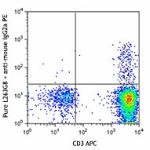
Human peripheral blood lymphocytes were stained with CD3 APC... 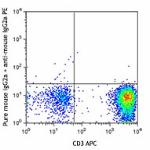
-
PE anti-human CD198 (CCR8)
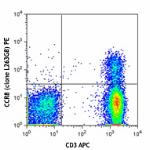
Human peripheral blood lymphocytes were stained with CD3 APC... 
-
Biotin anti-human CD198 (CCR8)
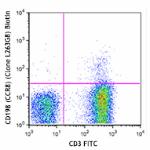
Human peripheral blood lymphocytes were stained with CD3 FIT... 
-
TotalSeq™-A0900 anti-human CD198 (CCR8)
-
APC anti-human CD198 (CCR8)

Human peripheral blood lymphocytes were stained with CD3 PE ... -
TotalSeq™-B0900 anti-human CD198 (CCR8) Antibody
-
TotalSeq™-C0900 anti-human CD198 (CCR8)
 Login / Register
Login / Register 










Follow Us